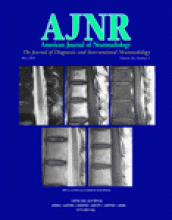Dr. Cartes-Zumelzu and colleagues (1) are to be commended for investigating diffusion-weighted imaging to monitor therapy of brain abscesses. Despite the limited specificity of DW imaging in the diagnosis of abscesses, its use in the surveillance of treated abscesses may demonstrate sufficient accuracy to guide therapy as the number of pathologic processes within an abscess cavity after evacuation is usually limited to pus resorption or reaccumulation, or to intracavitary hemorrhage. Detecting these changes before their appearance on conventional imaging and before the patient deteriorates and requires reintervention could lead to earlier preventive drainages and improved outcomes.
To prove the incremental value of DW imaging over conventional MR imaging in improving patient mortality and morbidity in a rigorous study offers a challenge. Such a study would be fraught with difficulties inherent in the variability of patient presentations, clinical courses and individual responses to treatment.
The details and design of Cartes-Zumelzu et al’s study deserve further evaluation. There are apparent mistakes in Table 2. Patient 2 is mentioned twice, in part A as having one drainage of the two abscesses and in part B as having one drainage of a single abscess. Patient 3 is omitted from the table, although the text states that drainage was performed on one of two abscesses. Inconsistencies are present in part B of the table in labeling times of follow-up imaging and placement of values into incorrect boxes. For example, the fourth follow-up in Table 2B shows “D” as the value when “D” represents drainage, not a time value. The DW imaging is listed as 1.17 when only high and low categories are possible. This puts in doubt the reliability of the table and, as a result, the entire table needs re-explanation.
No relationship is demonstrated between apparent diffusion coefficient (ADC) and DW values. Specifically, low DW is associated with ADC values of 0.51–2.95. High DW is associated with ADC values of 0.36–1.17, which is a near-complete overlap. Even if trends are considered, the independent behavior of ADC and DW is apparent. A fall of ADC from 2.61 to 1.57 is not reflected in a the change of DW from low to high in patient 7, whereas a rise of 0.41 to 0.51 converts DW from high to low in the second abscess of patient 6.
The authors do not state which value, DW or ADC, was used as the primary factor in the decision whether to perform drainage or to declare therapy successful. If both values were considered, how were inconsistencies between the two resolved, in light of the independent behavior of the two? Did the authors use a predefined threshold of ADC or a percentage fall as their decision threshold? The reader deserves a precise answer to this question.
Scrutiny of Table 2 and the results section reveals multiple violations of the presumed protocol to drain abscesses with low/falling ADC and observing ones with high/rising ADC. Patient 7 demonstrated a fall in ADC from 2.61 to 1.57 and the second abscess in patient 2 from Table 2A had ADC change from 1.12 down to 0.46, yet neither patient was drained. No further imaging was performed for either patient despite a falling ADC, presumably an unfavorable sign. For patient 2 in Table 2A, the first abscess showed a rising ADC, yet drainage was performed despite this good imaging sign, an apparent contradiction of the very hypothesis of the study.
The study is shortchanged into being simply narrative and descriptive in its methodology by the lack of statistical analysis of the numerical results generated.
Clear, reproducible, a priori definition of the decision threshold, adherence to the predefined protocol and accurate reporting of results would significantly improve the study. The current study appears to be flawed and, by itself, does not support use of DW in abscess imaging.
Reference
- Copyright © American Society of Neuroradiology












